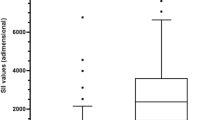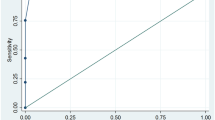Abstract
The primary objective of the present study was to compare outer diameter of the vermiform appendix on ultrasound, high-sensitivity C-reactive protein (hs-CRP), and serum bilirubin in complicated versus uncomplicated appendicitis. Eighty patients with a diagnosis of acute appendicitis clinically and with confirmation on ultrasound undergoing operative management were included for this prospective, observational study. All the patients underwent transabdominal ultrasonography for measurement of diameter of the appendix. Total serum bilirubin and hs-CRP levels were measured. The operative findings were objectively classified as a complicated appendix if perforation of the appendix, empyema or abscess formation, faecal peritonitis, and gangrenous appendix were noted. Chi-square test or Fisher’s exact test and unpaired ‘t’ test were used to compare categorical and continuous variables respectively. Receiver operating characteristics (ROC) curve was used for different cut-off points of appendicular diameter and hs-CRP. Sensitivity, specificity, positive predictive value, negative predictive value, and accuracy were calculated. Mean appendicular diameter and mean hs-CRP level were significantly higher among the patients with complicated appendicitis compared with the patients with uncomplicated appendicitis. Sensitivity was 86.1%, 94.4%, and 100.0% for appendicular diameter ≥ 7.95 mm, hs-CRP ≥ 6.60 mg/dL, and appendicular diameter ≥ 7.95 mm or hs-CRP ≥ 6.60 mg/dL respectively. Specificity was 88.6%, 90.9%, and 81.8% for appendicular diameter ≥ 7.95 mm, hs-CRP ≥ 6.60 mg/dL, and appendicular diameter ≥ 7.95 mm or hs-CRP ≥ 6.60 mg/dL respectively. Appendicular diameter and hs-CRP levels were useful to diagnose complicated appendicitis preoperatively.


Similar content being viewed by others
References
Prystowsky JB, Pugh CM, Nagle AP (2005) Appendicitis. Curr Probl Surg 42:694–742
Sabiston DC, Townsend CM (2002) Sabiston textbook of surgery: the biological basis of modern surgical practice. Saunders, Philadelphia
Styrud J, Eriksson S, Nilsson I, Ahlberg G, Haapaniemi S, Neovius G, Rex L, Badume I, Granström L (2006) Appendectomy versus antibiotic treatment in acute appendicitis. A prospective multicenter randomized controlled trial. World J Surg 30:1033–1037
Jamaluddin M, Hussain S, Ahmad H (2013) Hyperbilirubinaemia a predictive factor for complicated acute appendicitis: a study in a tertiary care hospital. J Pak Med Assoc 63(11):1374–1378
Chaudhary P, Kumar A, Saxena N, Biswal UC (2013) Hyperbilirubinemia as a predictor of gangrenous/perforated appendicitis: a prospective study. Ann Gastroenterol 26(4):325
Beltran MA, Mendez PE, Barrera RE, Contreras MA, Wilson CS, Cortes VJ, Cruces KS (2009) Is hyperbilirubinaemia in appendicitis a better predictor of perforation than C-reactive protein?—a prospective study. Indian Journal of Surgery 71:265–272
Harvey M (1995) Intuitive biostatistics. Oxford University Press, New York
Addiss DG, Shaffer N, Fowler BS, Tauxe RV (1990) The epidemiology of appendicitis and appendectomy in the United States. Am J Epidemiol 132:910–925
Kartal K, Yazıcı P, Ünlü TM, Uludağ M, Mihmanlı M (2017) How to avoid negative appendectomies: can US achieve this? Ulus Travma Acil Cerrahi Derg 23(2):134–138
Lin CJ, Chen JD, Tiu CM, Chou YH, Chiang JH, Lee CH, Chang CY, Yu C (2005) Can ruptured appendicitis be detected preoperatively in the ED? Am J Emerg Med 23:60–66
Kim TH, Cho BS, Jung JH, Lee MS, Jang JH, Kim CN (2015) Predictive factors to distinguish between patients with noncomplicated appendicitis and those with complicated appendicitis. Ann Coloproctol 31:192–197
Moon HM, Park BS, Moon DJ (2011) Diagnostic value of C-reactive protein in complicated appendicitis. J Kor Soc Coloproctol 27:122–126
Yu CW, Juan LI, Wu MH, Shen CJ, Wu JY, Lee CC (2013) Systematic review and meta-analysis of the diagnostic accuracy of procalcitonin, C-reactive protein and white blood cell count for suspected acute appendicitis. Br J Surg 100:322–329
Avanesov M, Wiese NJ, Karul M, Guerreiro H, Keller S, Busch P, Jacobsen F, Adam G, Yamamura J (2018) Diagnostic prediction of complicated appendicitis by combined clinical and radiological appendicitis severity index (APSI). Eur Radiol 28:3601–3610. https://doi.org/10.1007/s00330-018-5339-9. [Epub ahead of print]
Giordano S, Pääkkönen M, Salminen P, Grönroos JM (2013) Elevated serum bilirubin in assessing the likelihood of perforation in acute appendicitis: a diagnostic meta-analysis. Int J Surg 11(9):795–800
Adams HL, Jaunoo SS (2016) Hyperbilirubinaemia in appendicitis: the diagnostic value for prediction of appendicitis and appendiceal perforation. Eur J Trauma Emerg Surg 42(2):249–252
Chambers AC, Bismohun SL, Davies H, White P, Patil AV (2015) Predictive value of abnormally raised serum bilirubin in acute appendicitis: a cohort study. Int J Surg 13:207–210
Nevler A, Berger Y, Rabinovitz A, Zmora O, Shabtai M, Rosin D et al (2018) Diagnostic value of serum bilirubin and liver enzyme levels in acute appendicitis. Isr Med Assoc J 20(3):176–181
Burcharth J, Pommergaard HC, Rosenberg J, Gögenur I (2013) Hyperbilirubinemia as a predictor for appendiceal perforation: a systematic review. Scand J Surg 102(2):55–60
Author information
Authors and Affiliations
Corresponding author
Ethics declarations
Written informed consent was obtained from all the patients. Permission was obtained from ethics committee and scientific advisory committee of the institution.
Conflict of Interest
The authors declare that they have no conflict of interest.
Additional information
Publisher’s Note
Springer Nature remains neutral with regard to jurisdictional claims in published maps and institutional affiliations.
Rights and permissions
About this article
Cite this article
Parekh, D., Jain, D., Mohite, S. et al. Comparison of Outer Diameter of Appendix, C-reactive Protein, and Serum Bilirubin Levels in Complicated Versus Uncomplicated Appendicitis. Indian J Surg 82, 314–318 (2020). https://doi.org/10.1007/s12262-019-01931-2
Received:
Accepted:
Published:
Issue Date:
DOI: https://doi.org/10.1007/s12262-019-01931-2




